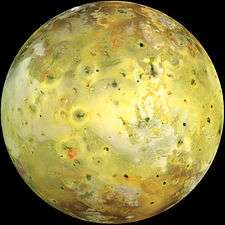Tidal heating

Tidal heating (also known as tidal working or tidal flexing) occurs through the tidal friction processes: orbital energy is dissipated as heat in either the surface ocean or interior of a planet or satellite. When an object is in an elliptical orbit, the tidal forces acting on it are stronger near periapsis than near apoapsis. Thus the deformation of the body due to tidal forces (i.e. the tidal bulge) varies over the course of its orbit, generating internal friction which heats its interior. This energy gained by the object comes from its gravitational energy, so over time in a two-body system, the initial elliptical orbit decays into a circular orbit (tidal circularization). Sustained tidal heating occurs when the elliptical orbit is prevented from circularizing due to additional gravitational forces that keep tugging the object back into an elliptical orbit. In this more complex system, gravitational energy still is being converted to thermal energy; however, now the orbit's semi-major axis shrinks rather than its eccentricity.
Tidal heating is responsible for the most volcanically active body in the solar system: Io, a moon of Jupiter. Io's eccentricity persists as the result of its orbital resonances with the other Galilean moons.[1] The same mechanism with weaker heating effects (because of a smaller eccentricity) is theorised to have provided the energy to melt the lower layers of the ice surrounding the rocky mantle of Jupiter's next closest large moon, Europa. Saturn's moon Enceladus is similarly thought to have a liquid water ocean beneath its icy crust due to tidal heating. The water vapor geysers which eject material from Enceladus are thought to be powered by friction generated within this moon's shifting ice crust.[2]
In the leading order over the inclination and eccentricity, the total amount of tidal heating in a satellite that is spin-synchronous and has an eccentric orbit is given by:
where , , and are respectively the satellite's mean radius, mean orbital motion, and eccentricity.[3] is the imaginary portion of the second-order Love number which measures the efficiency of body dissipation within the satellite. This imaginary portion is a function of the satellite's bulk shear modulus and viscosity. These in turn are dependent upon temperature and melting of the satellite's interior.[4]
See also
References
- ↑ Peale, S. J.; Cassen, P.; Reynolds, R. T. (1979), "Melting of Io by Tidal Dissipation", Science, 203 (4383): 892–894, Bibcode:1979Sci...203..892P, doi:10.1126/science.203.4383.892, JSTOR 1747884, PMID 17771724
- ↑ Peale, S.J. Tidally induced volcanism. Celest. Mech. & Dyn. Astr. 87, 129– 155, 2003.
- ↑ Segatz, M., T. Spohn, M. N. Ross, and G. Schubert. 1988. “Tidal Dissipation, Surface Heat Flow, and Figure of Viscoelastic Models of Io.” Icarus 75: 187. doi:10.1016/0019-1035(88)90001-2.
- ↑ Efroimsky, Michael. 2012. “Tidal Dissipation Compared to Seismic Dissipation: In Small Bodies, in Earths, and in Superearths.” The Astrophysical Journal 746: 150–86. doi:10.1088/0004-637X/746/2/150.